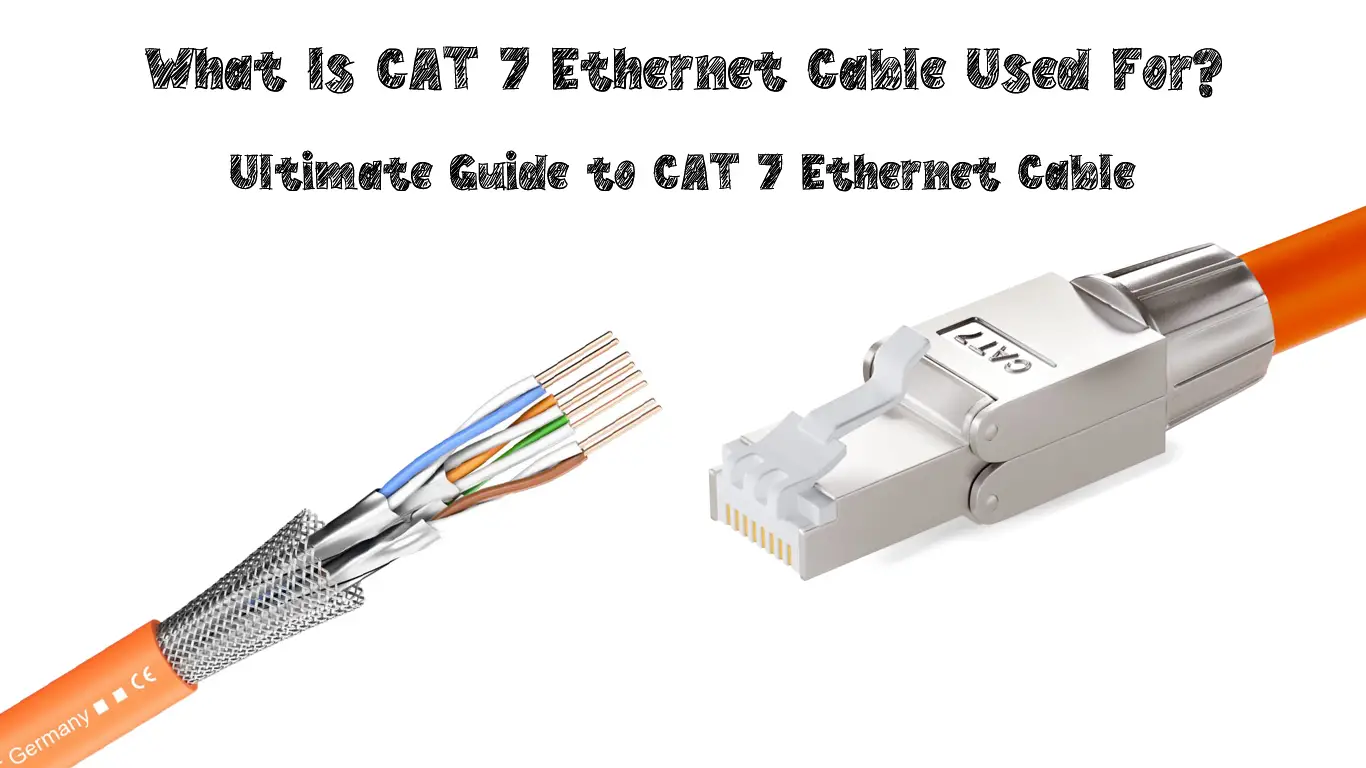When buying a good-quality Ethernet cable, you might easily conclude that a higher number in the name usually means a higher-quality Ethernet cable. So, for example, a standard Cat 6 cable will always have better characteristics than a standard Cat 5e or Cat 5, and so on.
This is also the case with Cat 7 cable – a good-quality Cat 7 cable should always perform better than a Cat 6/Cat 6A cable. However, it is important to point out that Cat 7 is not actually a standard officially recognized by TIA/EIA (Telecommunications Industries Association/Electronic Industries Association). This practically means that when you buy a Cat 7 cable, there’s no guarantee regarding what you are getting from the standardization perspective.
So, unlike the other standard Ethernet cables currently available on the market (Cat 5e, Cat 6, Cat 6A, and Cat 8), when buying a Cat 7 cable, you have to solely rely on the promise of the manufacturer regarding the specifications of the cable you are buying.
Still, the fact that Cat 7 is not a TIA/EIA-recognized standard does not necessarily mean that Cat 7 cables are not worth it. Moreover, if we just take a look at the current state regarding the standardization of coaxial cabling, we’ll see that most of these widely used cables (like RG-6, for example) are not really built upon a recognized standard either.
In this article, we will explain what characteristics you should expect to see in a good quality Cat 7 cable, what to look for if you want to buy one, and why you might still want to use a Cat 6/Cat 6A or Cat 8 cable instead of Cat 7.
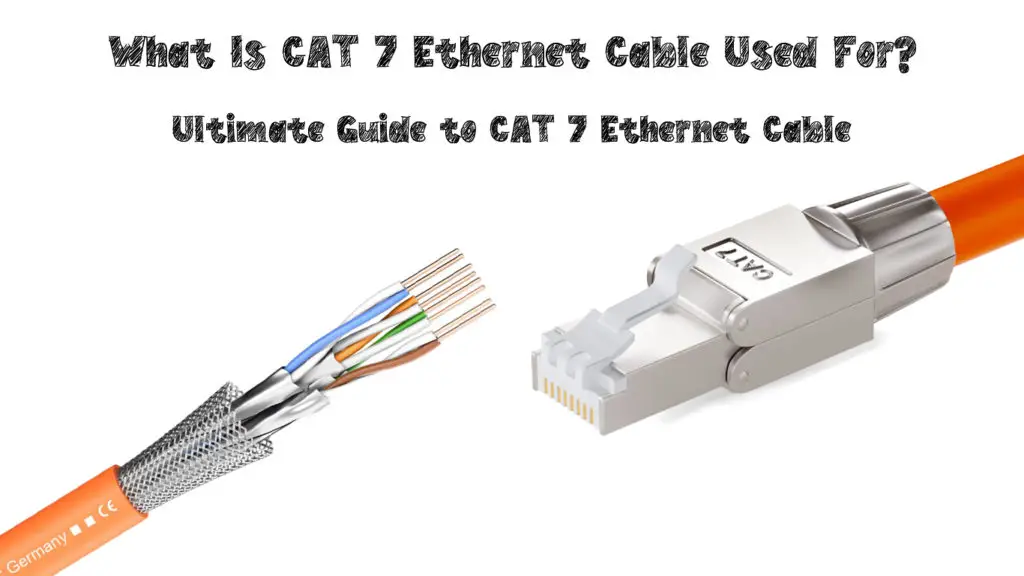
CONTENTS
- Cat 7 / Class F Standard Explained
- What is Cat 7 Ethernet Cable?
- Is Cat 7 Better Than Cat 6 or Cat 6A?
- Cat 7 vs. Cat 8
- What is Cat 7A Ethernet Cable?
- Should I Use Cat 7 Ethernet Cable for Wiring My Entire Home?
- What Is a Cat 7 Flat Ethernet Cable?
- Is Cat 7 Ethernet Cable Good for Gaming and Streaming
- Is Cat 7 Ethernet Cable Worth It?
- What to Look for When Buying a Cat 7 Cable
- Best Cat 7 Ethernet Cables to Buy Right Now
- 1. Best Cat 7 Cable for Wiring Your Entire Home – Elite CAT 7A Shielded Riser Ethernet Cable
- 2. Best Outdoor-Rated Cat 7 Cable – Hftywy Double-Shielded Ethernet Cable
- 3. Best Cat 7 Patch Cable – UGREEN High-Speed Braided Ethernet Cable
Cat 7 / Class F Standard Explained
Unlike other Ethernet cables that can be found on the market, Cat 7 cable is not a fully recognized standard. When we say it is not a fully recognized standard, we mean that there’s no such thing as a Cat 7 cable officially, at least not for the North American region.
TIA is an organization that defines the standards for telecommunication equipment for the North American region primarily. However, another organization does the same thing on a global level – it’s called ISO (International Organization for Standardization), and, in most cases, TIA follows up with the standards released by ISO and ratifies them for the North American region.
So, when it comes to networking equipment standardization, TIA and ISO standards are practically very similar, even though slightly different naming is used in some cases. For example, the TIA standards use the “category” naming to describe both the cables and the related networking equipment, as well as the whole link channel that these devices form together. On the other hand, ISO uses the “category” naming just for the equipment (including the cables), and the channel is named as a “class”.
For example, an equivalent of TIA Cat 5e standard would be ISO Class D channel; for Cat 6, it’s Class E, Cat 6A is Class EA, Cat 7 would be Class F, and so on.
In 2002 ISO/IEC 11801 standard was introduced, and the Category 7 cabling designed to support the new Class F channel was ratified accordingly. Cat 7 cabling was meant to improve performance by reducing the inner and outer crosstalk. Thus, shielding around each of the twisted pairs was introduced as a requirement alongside the outer braided metal shielding and was rated for frequencies of up to 600 MHz.
With these specs, Cat 7 would easily meet the requirement of supporting 10 Gbps data transfer speeds. However, the whole Channel F technology, including Cat 7 cables, was a bit ahead of its time. For example, the 10GBASE-T IEEE standard that would support 10 Gbps data transfer speeds over the Ethernet was eventually introduced long four years later.
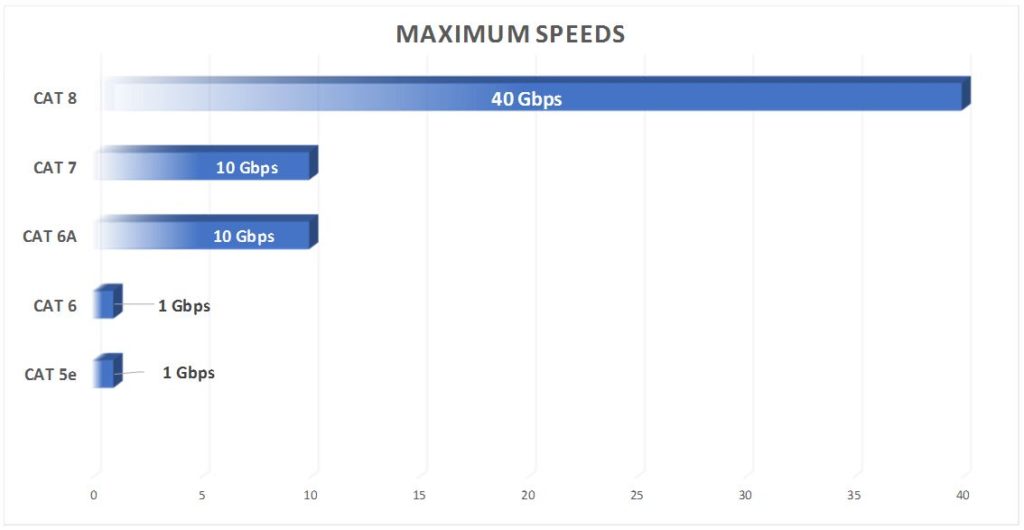
By the time 10GBASE-T technology was finally ready to hit the markets, the Cat 6A cable (that would also support 10 Gbps speeds) was already widely popular and was cheaper to manufacture than a Cat 7 cable.
On the other hand, TIA was a bit late with ratifying these standards. When Cat 7 standard was introduced in 2002 by ISO, it was practically useless for the North American region as there weren’t any strict requirements regarding the networking cabling shielding as this was the case in Europe, and the technology that would be able to achieve 10 Gbps data transfer speeds was pretty much non-existent back then.
Eventually, in 2006 when the 10GBASE-T technology was finally about to hit the markets, Cat 6A cabling was already sufficient to support that technology, and TIA simply “skipped” the adoption of the Cat 7 standard and ratified Cat 6A instead in 2008, which was already widely in use by that time.
Besides being way ahead of its time, Cat 7 cabling was meant to bring a fundamental change to the networking technology by introducing new types of connectors that these cables were originally built for – GG45 and Terra connectors. While these new types of shielded connectors were way better in preventing signal loss compared to regular RJ-45 connectors, they simply did not find any decent support on the market and eventually became obsolete.
Cat 7 cables, however, did continue to exist on the market but are usually terminated with just regular shielded RJ-45 connectors. Still, with the emergence of the Cat 8 standard, which also requires fully shielded cables rated for way higher speeds than Cat 7 cables, Cat 7 cables will probably remain less popular.
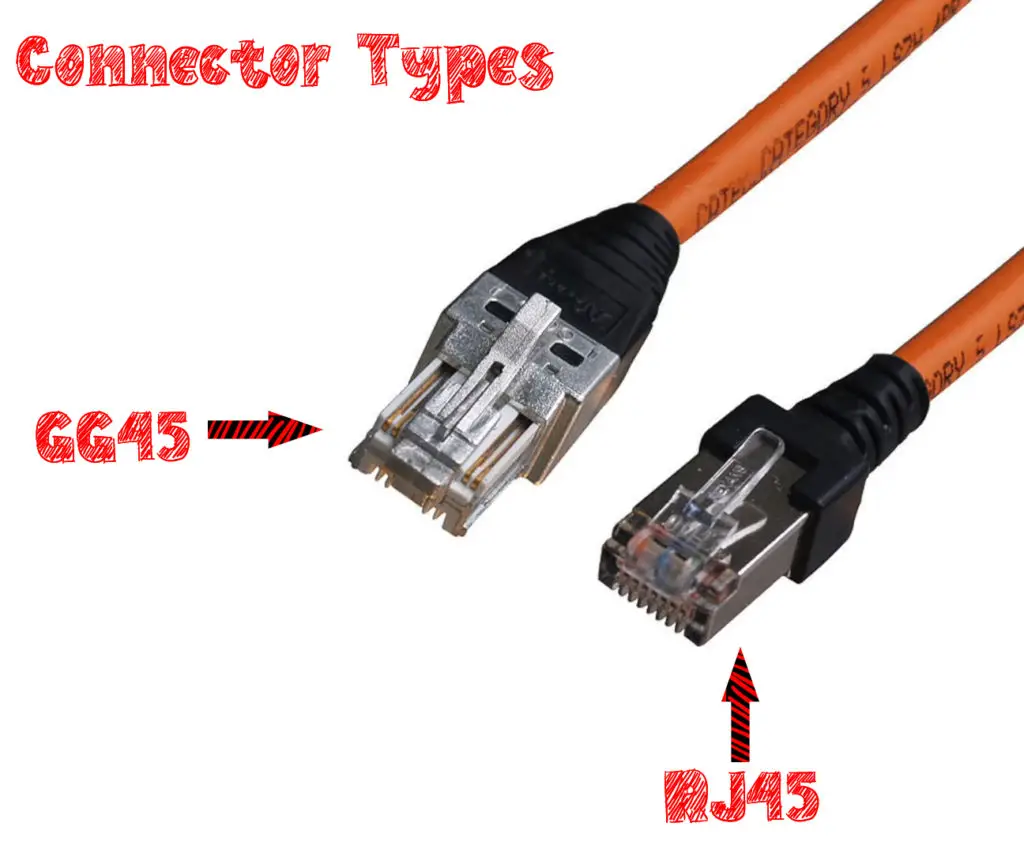
What is Cat 7 Ethernet Cable?
A standard Cat 7 Ethernet cable (according to ISO/IEC 11801:2002 standard) is rated for frequencies up to 600 MHz and supports data transfer speeds of up to 10 Gbps over 100 meters distances. It is a fully shielded twisted pair cable with both outer and inner shielding – the outer shielding is usually made of braided metal and sometimes followed by a layer of aluminum foil, and the inner shielding around each of the four twisted pairs is usually made of aluminum foil.
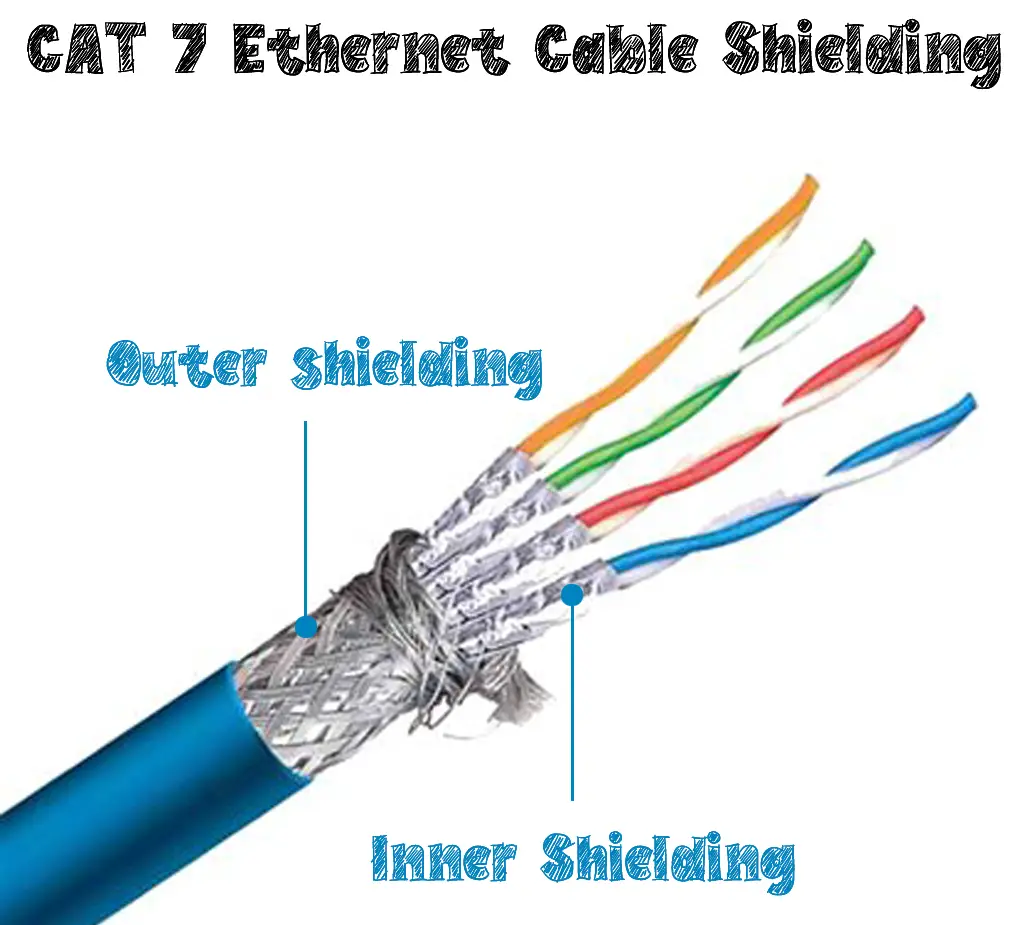
Cat 7 ethernet cable was originally designed to work with GG-45 or TERA connectors. However, these connectors are considered obsolete nowadays, and most Cat 7 ethernet cables you can buy today are terminated with a regular shielded RJ-45 connector.
Is Cat 7 Better Than Cat 6 or Cat 6A?
Cat 6 ethernet cable is rated for frequencies of up to 250 MHz and can support 10 Gbps data transfer speed at a distance of up to 55 meters.
Therefore, a good Cat 7 cable should be better than a regular Cat 6 cable as Cat 7 cable should support 10 Gbps speeds over a full 100 meters distance and work with higher frequencies (up to 600 MHz).
However, compared with Cat 6A, which supports 10 Gbps over 100 meters and is rated for frequencies of up to 500 MHz, Cat 7 is not much better. The difference in performance between Cat 7 and Cat 6A would be hardly noticeable within home-grade networks.
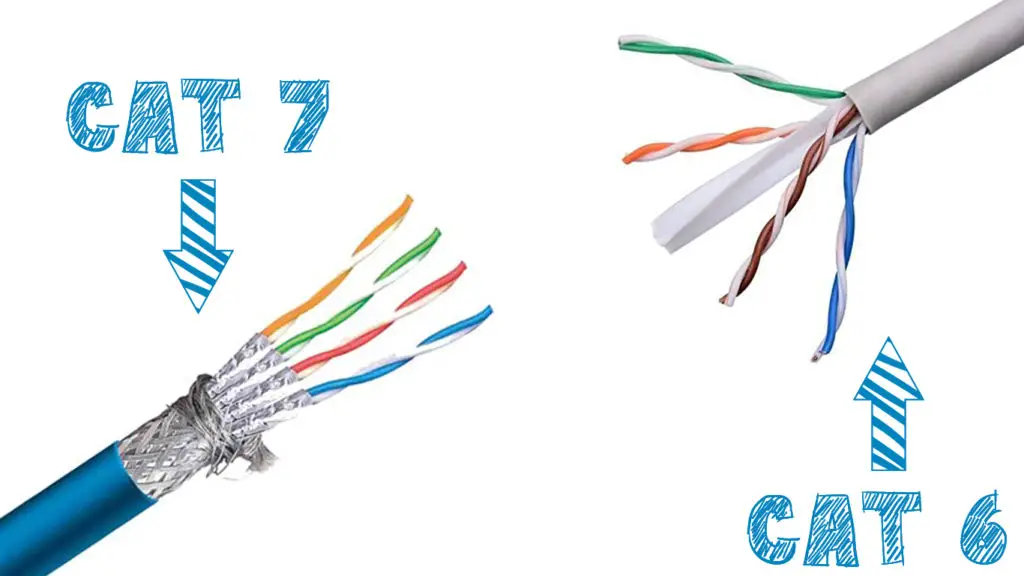
Cat 7 should still be better than a regular unshielded Cat 6A cable in cases when better protection from inner and outer crosstalk is required. For example, if you need a good patch cable to connect your gaming console to the internet, using a good Cat 7 cable could theoretically give you a slightly better ping rate than a regular unshielded Cat 6A cable.
When it comes to the cost, Cat 7 cables are usually more expensive than Cat 6A cables. Also, considering that there are also shielded Cat 6 and Cat 6A cables that still cost less than a Cat 7 cable, Cat 7 cables might not be the best choice whenever you need longer runs.
Cat 6 vs Cat 7 Ethernet Cables
Cat 7 vs. Cat 8
Both Cat 7 and Cat 8 Ethernet cables are fully shielded, which means they have aluminum foil shielding around each of the twisted pairs. They also have outer braided metal shielding, and both types of cables come with fully shielded RJ-45 connectors.
This means that both of these types of cables will perform similarly, and this is especially the case in home-grade networks.
Cat 7 is rated for 10 Gbps speeds up to 100 meters and for frequencies of up to 600 MHz, while Cat 8 is rated for 40 Gbps speeds up to 55 meters and supports frequencies up to 2000 Mhz.
Cat 7 cables are still slightly cheaper compared to Cat 8. However, given that Cat 8 is a way more convenient way to go if you want to have a high-end Ethernet cable, paying the price difference might be more than worth it. Besides the fact that Cat 8 cable can support higher speeds and provide a more reliable connection, it is also important to note that Cat 8 is also way more reliable regarding what you are paying for since it is a fully recognized standard which is not the case with the Cat 7 cable.
It is important to point out that both of these cable types are far beyond what regular home-grade networking equipment requires nowadays. For example, the Ethernet ports you can find on your router, laptop, or TV usually do not support speeds higher than 2.5 Gbps.
Therefore, even the cheaper Cat 6 or Cat 6A cables would be more than enough for regular home-grade networks.
So the only case when you might want to have a Cat 7 or Cat 8 cable would be either if you need a specific run (a patch cable) to be fully shielded and have better protection from electromagnetic interference or if you want to have a more future-proof Ethernet cabling installation in your home that will be able to work with multi-gigabit internet speeds in the future.
What’s the Difference Between Cat 7 and Cat 8 Ethernet Cables?
What is Cat 7A Ethernet Cable?
Similar to how Cat 6A is an improved version of Cat 6 cables, Cat 7A is a more recent version of Cat 7.
The main difference between Cat 7 and Cat 7A is that the latter is rated for higher frequencies. Cat 7 works with a frequency range of up to 600 MHz, while Cat 7A can support frequencies up to 1000 MHz.
The difference is almost insignificant for home-grade networks, but, essentially, given that it is rated for a higher operating frequency range, Cat 7A cable will offer better performance.
Should I Use Cat 7 Ethernet Cable for Wiring My Entire Home?
There are a couple of reasons why you might want to avoid using Cat 7 cables for permanent installations like wiring your entire home or office.
Let’s say that the whole thing with the Cat 7 standard not being fully recognized is irrelevant and that you have a trustworthy manufacturer who provides a good-quality Cat 7 cable. Even in that case, you might want to stick with the more standard options like Cat 6A or Cat 8.
Cat 6A is rated for 10 Gbps speeds up to 100 meters and is much cheaper than a Cat 7 cable that would offer very similar performance anyways. Even if you are in a really “noisy” environment where you need that extra shielding to protect your cabling from the crosstalk, you can still probably find a decent shielded Cat 6A cable that would cost less than a Cat 7.
On the other hand, if you want something that would last longer and you are willing to pay a bit more, you could simply get a decent Cat 8 cable instead, which is rated for 40 Gbps speeds up to 30 meters distances.
So, essentially, yes, you could use a good Cat 7 cable to wire your entire home; however, the fact that a shielded Cat 6A would practically give the same performance and cost less makes it very hard to justify using Cat 7 cabling.
The same goes when compared with Cat 8 – if you are willing to pay the buck for a decent Cat 7 cable, then you might want to consider adding a bit more to your budget and having a good Cat 8 cable that is a recognized standard and the best that you can currently get on the market.
It is important to point out that Cat 6 and Cat 6A cables should be more than good enough for most home-grade installations.
Cat 5e, Cat 6, Cat 6A, Cat 7, Cat 8 – Which One Should You Use for Home Installations?
What Is a Cat 7 Flat Ethernet Cable?
If you are shopping around for a Cat 7 cable, you might notice that there are plenty of those fancy-looking Cat 7 flat ethernet cables. The truth is that there’s no such thing as a standardized flat ethernet cable – whether it be Cat 6, Cat 6A, Cat 7, or Cat 8 – none of these cables are meant to be flat.
The flat design negatively affects the cable’s performance because ethernet cables are made of four twisted pairs of copper wires, and these pairs are not meant to be aligned like in flat cables.
Still, in most cases, this design will probably not have any noticeable impact on the performance of home-grade networks as the devices currently used usually can only work with 1-2.5 Gigabit speeds. So, if you buy a flat Ethernet cable, you might find that it works just fine for your setup, but essentially, their performance won’t be as good as regular round cables would perform if you put them to a more intense test with network equipment that supports actual 10-Gigabit speeds.
Therefore, the only reason you might want to have a flat ethernet cable would be if you just need a patch cable that will look good enough on your wall and hopefully provide a good enough or at least not-so-horrible performance.
What’s the Problem with Flat Ethernet Cables?
Is Cat 7 Ethernet Cable Good for Gaming and Streaming
Any standard ethernet cable should be good enough for connecting your gaming devices or smart TVs to the internet. So, a good Cat 7 cable should be more than good enough for such use cases. Moreover, Cat 7 cable, given that it is a fully shielded cable by default, will probably be way better than Cat 6 or Cat 6A if you are trying to reduce your latency to the minimum.
However, if you are doing a permanent wiring installation, we recommend that you should still use either Cat 6A or Cat 8 Ethernet cables.
Is Cat 7 Ethernet Cable Worth It?
Cat 7 ethernet cable might not be the best choice if you plan to wire your entire home for Ethernet. The fact that serious cable manufacturers will most likely avoid producing this cable because it’s not a fully recognized standard is just one of the reasons why you might want to go for either Cat 6, Cat 6A, or Cat 8 when wiring your entire home.
If you need a fully shielded Ethernet cable for wiring your home but don’t want to pay for Cat 8, you could still consider using a fully shielded Cat 6 or Cat 6A cable instead of Cat 7, as they might be cheaper while offering the same performance.
Another reason not to use Cat 7 for permanent wiring is that it is not that much cheaper than Cat 8, which has all the features of Cat 7 (fully shielded with shielded connectors) and is rated for way higher data transfer speeds.
Cat 7 cable might be a good choice when you need a single patch cable that requires better protection from electromagnetic interference. However, even in this case, it might be wiser to go with Cat 8.
Another reason you might want to think twice before buying a Cat 7 cable is that these cables are not as present on the market as the other standard Ethernet cables, and it’s not always easy to find a good one to buy.
What to Look for When Buying a Cat 7 Cable
When buying a Cat 7 Ethernet cable, there are several things to pay attention to.
Cat 7 Cables Should Be Fully Shielded
A good Cat 7 Ethernet cable should be fully shielded, meaning each of the four twisted pairs should be shielded separately with aluminum foil. On top of that, it needs to have an outer shielding as well – usually, another layer of aluminum foil followed by braided metal shielding.
Cat 7 Requires Shielded RJ-45 Connectors
Shielded Ethernet cables, including Cat 7, should always be terminated with shielded connectors. This is because shielded connectors play an important role in preventing signal losses at the so-called points of egress and ingress. This is so important for shielded cables that oftentimes, you’ll find that Cat 7 and Cat 8 cables are terminated with gold-plated RJ-45 connectors.
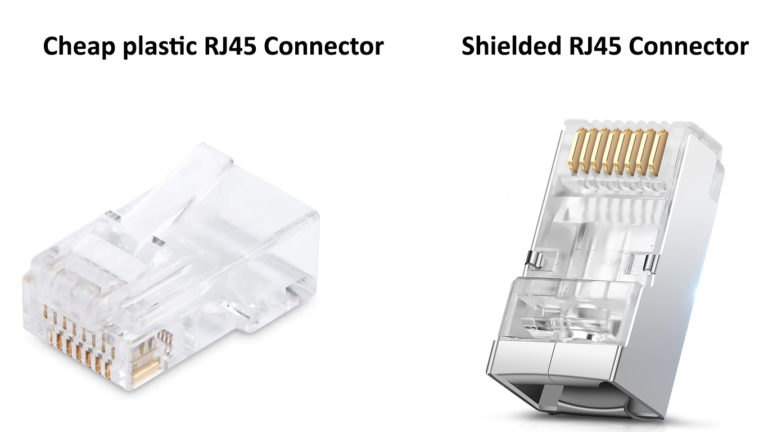
Cat 7 Ethernet Cables Should Not Be Flat
A good Ethernet cable, including Cat 7, should never be flat. There’s no such thing as a flat Ethernet cable – at least not according to the standards. This is important to point out since there are plenty of such cables sold labeled as “Cat 7”.
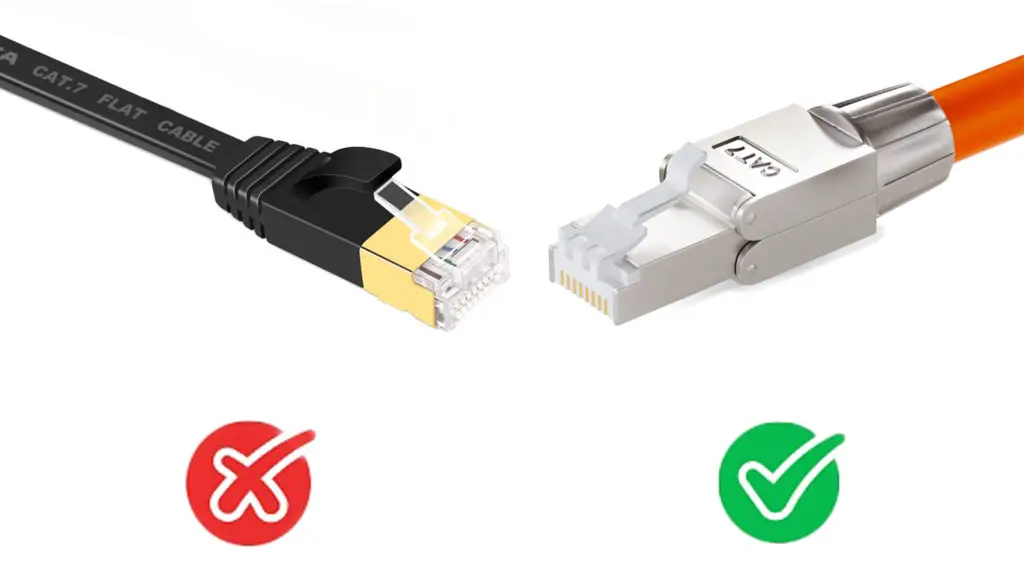
A Trustworthy Manufacturer
Since Cat 7 is not a fully recognized standard, most established cable manufacturers will just stick with regular Cat 6, Cat 6A, or Cat 8 cables avoiding dealing with Cat 7. This means that you might want to pay more attention to the cable manufacturer when buying one of these. It is more likely that a good Cat 7 cable might come from a European or Asian manufacturer that doesn’t necessarily have to comply with the TIA/EIA standards.
Copper Conducting Core
Any Ethernet cable, including Cat 7, should have a stranded or solid copper conducting core. Copper-clad aluminum or aluminum conducting cores are not compliant with ethernet cabling standards by any means. Using such cables can be highly dangerous when you need to use them for powering devices over the Ethernet.
Why You Should Avoid Ethernet Cables with CCA Conducting Core
RouterCtrl.com is reader supported. If you buy something using the links on our site, we may earn a small commission.
Best Cat 7 Ethernet Cables to Buy Right Now
1. Best Cat 7 Cable for Wiring Your Entire Home – Elite CAT 7A Shielded Riser Ethernet Cable
If you are looking for a high-quality Cat 7 cable that will perform almost as good as a Cat 8 cable and still sells for a reasonable price, this Elite Cat 7A cable is probably one of the best that you can buy right now.
It is a reliable and good-quality Cat 7A cable, fully shielded with 23 AWG solid copper core conductors. It is rated for up to 1000 MHz frequencies and will easily support 10 Gbps data transfer speeds.
This is a fully tested cable and a great choice if you live in an area where additional protection from electromagnetic interference is required.
Given that it features a solid copper 23 AWG core and is fully shielded, this is probably the best you can get from a Cat 7 cable.
2. Best Outdoor-Rated Cat 7 Cable – Hftywy Double-Shielded Ethernet Cable
This Hftywy’s Cat 7 cable is a great choice if you need a shielded cable that can be installed outdoors. It is fully outdoor rated, fully shielded, and is sold with a lifetime warranty.
It is a great choice if you need an outdoor run that can be properly grounded.
This cable comes ready-made – terminated with shielded RJ-45 connectors.
3. Best Cat 7 Patch Cable – UGREEN High-Speed Braided Ethernet Cable
If you need a good quality patch cable to connect your devices directly to the router, this UGREEN’s Cat 7 cable should be a good choice.
It is a fully shielded cable with a cotton braided outer jacket that makes this cable highly durable and more resilient to physical damage.
It comes with nickel-plated connectors with gold-plated contacts.

Hey, I’m Jeremy Clifford. I hold a bachelor’s degree in information systems, and I’m a certified network specialist. I worked for several internet providers in LA, San Francisco, Sacramento, and Seattle over the past 21 years.
I worked as a customer service operator, field technician, network engineer, and network specialist. During my career in networking, I’ve come across numerous modems, gateways, routers, and other networking hardware. I’ve installed network equipment, fixed it, designed and administrated networks, etc.
Networking is my passion, and I’m eager to share everything I know with you. On this website, you can read my modem and router reviews, as well as various how-to guides designed to help you solve your network problems. I want to liberate you from the fear that most users feel when they have to deal with modem and router settings.
My favorite free-time activities are gaming, movie-watching, and cooking. I also enjoy fishing, although I’m not good at it. What I’m good at is annoying David when we are fishing together. Apparently, you’re not supposed to talk or laugh while fishing – it scares the fishes.

